load capacity OLDSMOBILE SILHOUETTE 1995 Owners Manual
[x] Cancel search | Manufacturer: OLDSMOBILE, Model Year: 1995, Model line: SILHOUETTE, Model: OLDSMOBILE SILHOUETTE 1995Pages: 390, PDF Size: 20.27 MB
Page 130 of 390
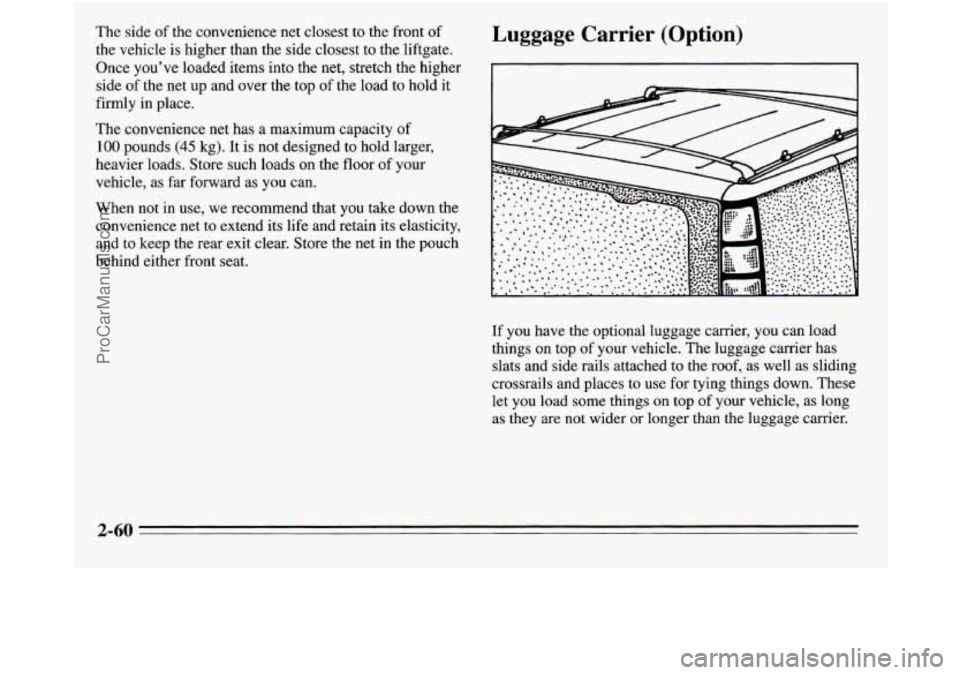
The side of the convenience net closest to the front of
the vehicle is higher than the side closest to the liftgate.
Once you’ve loaded items into the net, stretch the higher
side
of the net up and over the top of the load to hold it
firmly in place.
The convenience net has a maximum capacity
of
100 pounds (45 kg). It is not designed to hold larger,
heavier loads. Store such loads on the floor
of your
vehicle,
as far forward as you can.
When not
in use, we recommend that you take down the
convenience net to extend its life and retain its elasticity,
and to keep the rear exit clear. Store the net in the pouch
behind either front seat.
Luggage Carrier (Option)
If you have the optional luggage carrier, you can load
things on top of your vehicle. The luggage carrier has
slats and side rails attached to the roof, as well as sliding
crossrails and places to use for tying things down. These
let you load some things on top
of your vehicle, as long
as they are not wider or longer than the luggage carrier.
2-60
ProCarManuals.com
Page 132 of 390
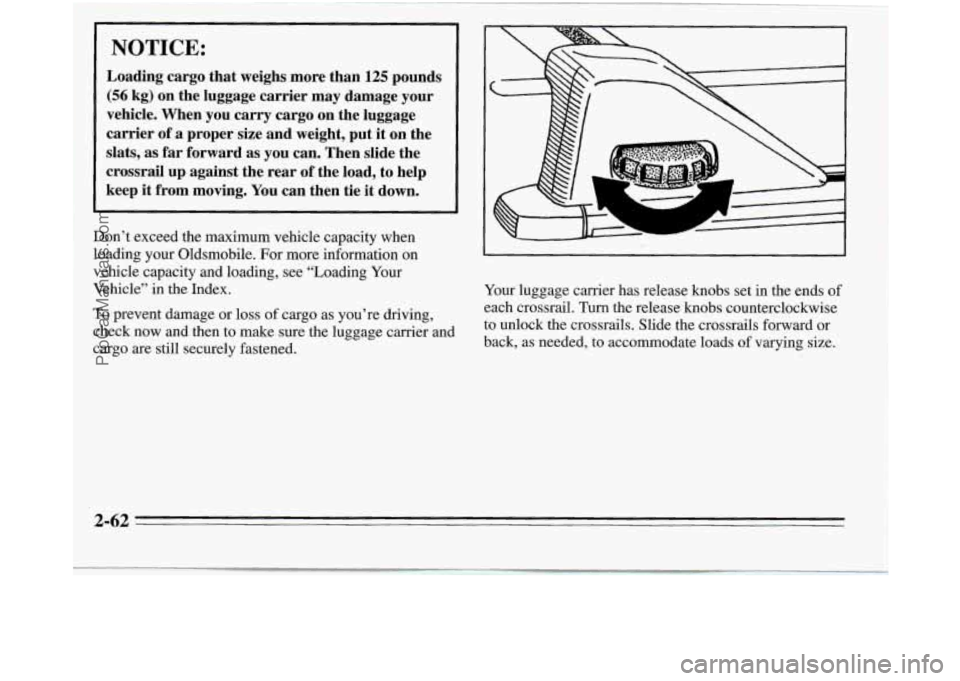
NOTICE:
Loading cargo that weighs more than 125 pounds
(56 kg) on the luggage carrier may damage your
vehicle. When you carry cargo
on the luggage
carrier of
a proper size and weight, put it on the
slats,
as far forward as you can. Then slide the
crossrail up against the rear
of the load, to help
keep
it from moving. You can then tie it down.
Don’t exceed the maximum vehicle capacity when
loading your Oldsmobile. For more information on
vehicle capacity and loading, see “Loading Your
Vehicle” in the Index.
To prevent damage or loss of cargo as you’re driving,
check now and then to make sure the luggage carrier and
cargo are still securely fastened.
4 I
Your luggage carrier has release knobs set in the ends of
each crossrail. Turn the release
knobs counterclockwise
to unlock the crossrails. Slide the crossrails forward or
back, as needed, to accommodate loads
of varying size.
2-62
ProCarManuals.com
Page 211 of 390
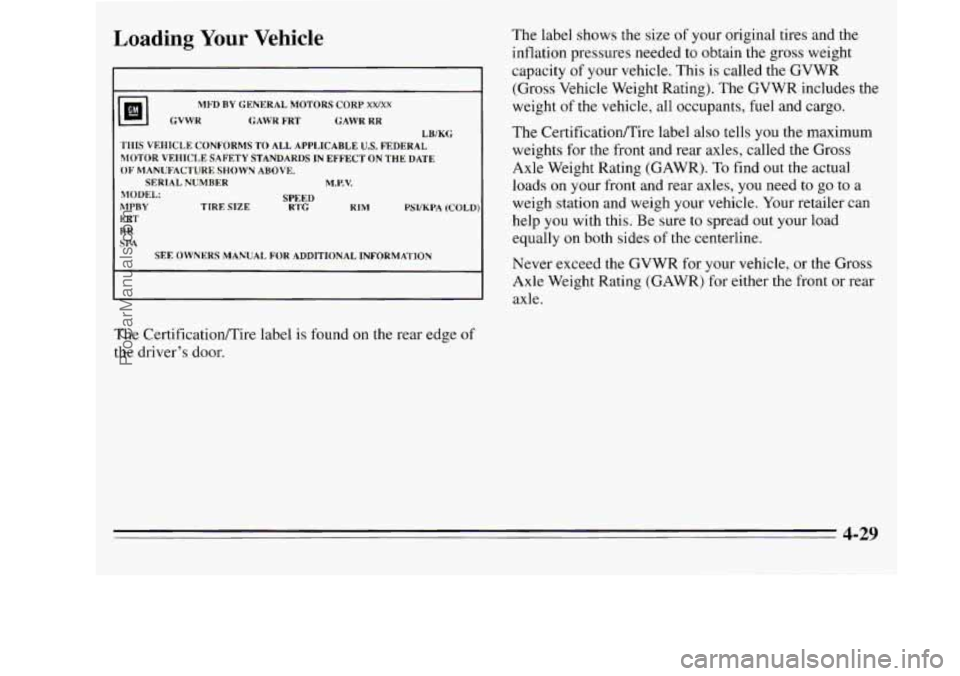
Loading Your Vehicle
11BI CVWR
MFD BY GENERAL MOTORS CORP XWXX
GAWR FRT GAWR RR LB/KG
THIS VEHICLE CONFORMS TO ALL APPLICABLE U.S. FEDERAL
MOTOR VEHICLE SAFETY STANDARDS IN EFFECT ON THE DATE
OF MANUFACTURE SHOWN ABOVE.
SERIAL NUMBER M.P.V.
MODEL:
MPBY
FRT
RR
SPA
SPEED
TIRE SIZE RTG RIM PSI/KPA (COLD
SEE OWNERS MANUAL FOR ADDITIONAL INFORMATION
The CertificatiodTire label is found on the rear edge of
the driver's door. The label
shows the size
of your original tires and the
inflation pressures needed to obtain the gross weight
capacity of your vehicle. This is called the GVWR
(Gross Vehicle Weight Rating). The GVWR includes the
weight
of the vehicle, all occupants, fuel and cargo.
The CertificatiodTire label also tells you the maximum
weights for the front and rear axles, called the Gross
Axle Weight Rating (GAWR). To find out the actual
loads on your front and rear axles,
you need to go to a
weigh station and weigh your vehicle. Your retailer can
help you with this. Be sure to spread out your load
equally on both sides of the centerline.
Never exceed the GVWR for your vehicle,
or the Gross
Axle Weight Rating (GAWR) for either the front or rear
axle.
4-29
ProCarManuals.com
Page 213 of 390
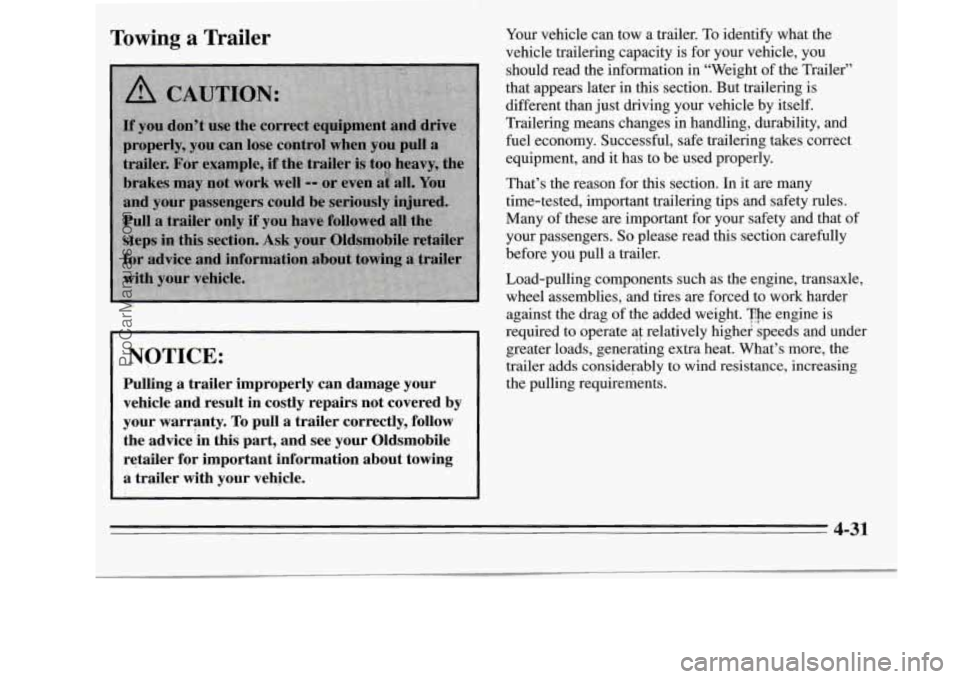
Towing a Trailer
NOTICE:
Pulling a trailer improperly can damage your vehicle and’result in costly repairs not covered by
your warranty.
To pull a trailer correctly, follow
the advice‘in this part, and see your Oldsmobile
retailer for important information about towing a trailer with your vehicle.
Your vehicle can tow a trailer. To identify what the
vehicle trailering capacity is for your vehicle, you
should read the information in “Weight of the Trailer”
that appears later in this section. But trailering is
different than just driving your vehicle by itself.
Trailering means changes in handling, durability, and
fuel economy. Successful, safe trailering takes correct
equipment, and it has to be used properly.
That’s the reason for this section. In it are many
time-tested, important trailering tips and safety rules.
Many of these are important for your safety and that of
your passengers.
So please read this section carefully
before you pull a trailer.
Load-pulling components such as the engine, transaxle,
wheel assemblies, and tires are forced to work harder
against the drag of the added weight. The engine is
required
‘to operate ai relatively highei speeds and under
greater loads, generating extra heat. What’s more, the
trailer adds considerably to wind resistance, increasing
the pulling requirements.
4-31
ProCarManuals.com
Page 215 of 390
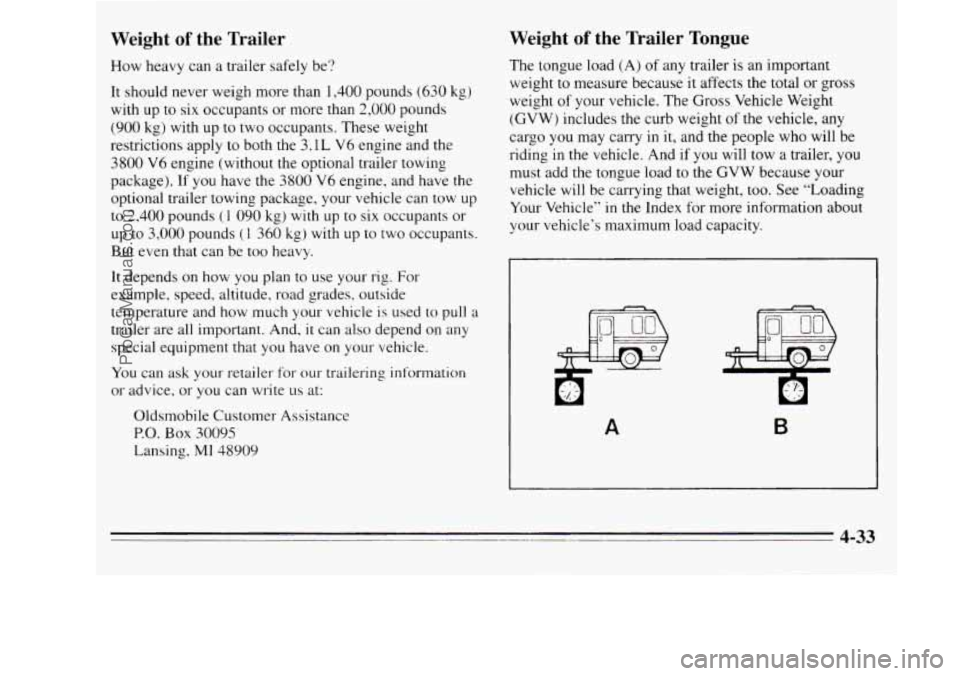
Weight of the Trailer
How heavy can a trailer safely be?
It should never weigh more than 1,400 pounds (630 kg)
with up to six occupants or more than 2,000 pounds
(900 kg) with up to two occupants. These weight
restrictions apply to both the
3.1L V6 engine and the
3800 V6 engine (without the optional trailer towing
package).
If you have the 3800 V6 engine, and have the
optional trailer towing package, your vehicle can tow up
to 2,400 pounds
(I 090 kg) with up to six occupants or
up
to 3,000 pounds (1 360 kg) with up to two occupants.
But even that can be too heavy.
It depends on how you plan to use your rig. For
example, speed, altitude, road grades, outside
temperature and how much your vehicle is used to pull
a
trailer are all important. And, it can also depend on any
special equipment that
you have on your vehicle.
You can ask your retailer for our trailering information
or advice, or
you can write us at:
Oldsmobile Customer Assistance
P.O. Box 30095
Lansing,
MI 48909
Weight of the Trailer Tongue
The tongue load (A) of any trailer is an important
weight to measure because it affects the total
or gross
weight
of your vehicle. The Gross Vehicle Weight
(GVW) includes the curb weight of the vehicle, any
cargo you may carry
in it, and the people who will be
riding in the vehicle. And
if you will tow a trailer, you
must add the tongue load to the GVW because your
vehicle will be carrying that weight,
too. See “Loading
Your Vehicle” in the Index for more information about
your vehicle’s maximum load capacity.
A B
4-33
ProCarManuals.com
Page 300 of 390
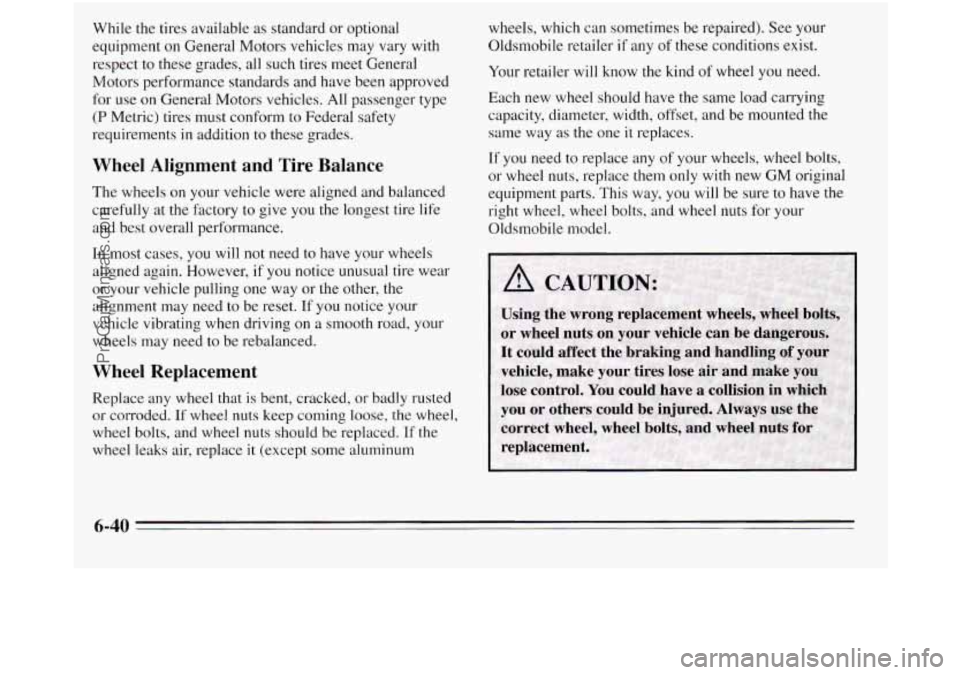
While the tires available as standard or optional
equipment
on General Motors vehicles may vary with
respect to these grades, all such tires meet General
Motors performance standards and have been approved
for use on General Motors vehicles. All passenger type
(P Metric) tires must conform to Federal safety
requirements in addition to these grades.
Wheel Alignment and Tire Balance
The wheels on your vehicle were aligned and balanced
carefully at the factory to give you the longest tire life
and best overall performance.
In most cases, you will not need to have your wheels
aligned again. However, if you notice unusual tire wear
or your vehicle pulling one way or the other, the
alignment may need to be reset.
If you notice your
vehicle vibrating when driving on
a smooth road, your
wheels may need to be rebalanced.
Wheel Replacement
Replace any wheel that is bent, cracked, or badly rusted
or corroded.
If wheel nuts keep coming loose, the wheel,
wheel bolts, and wheel nuts should be replaced. If the
wheel leaks air, replace it (except some aluminum wheels,
which can sometimes be repaired). See your
Oldsmobile retailer
if any of these conditions exist.
Your retailer will know the kind of wheel you need.
Each new wheel should have the same load carrying
capacity, diameter, width, offset, and be mounted the
same way as the one it replaces.
If you need to replace any of your wheels, wheel bolts,
or wheel nuts, replace them only with new GM original
equipment parts. This way, you will be sure
to have the
right wheel, wheel bolts, and wheel nuts for your
Oldsmobile model.
6-40
ProCarManuals.com